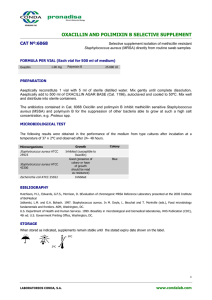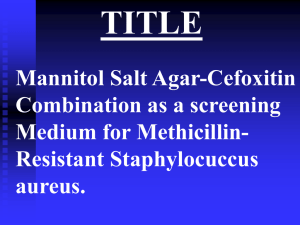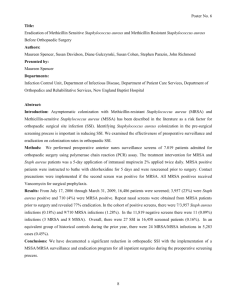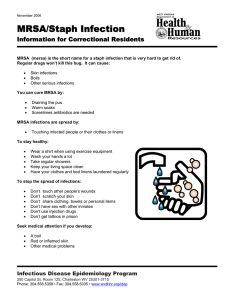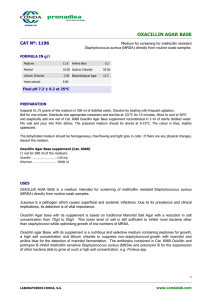Evaluation of various methods for the detection of meticillin
advertisement
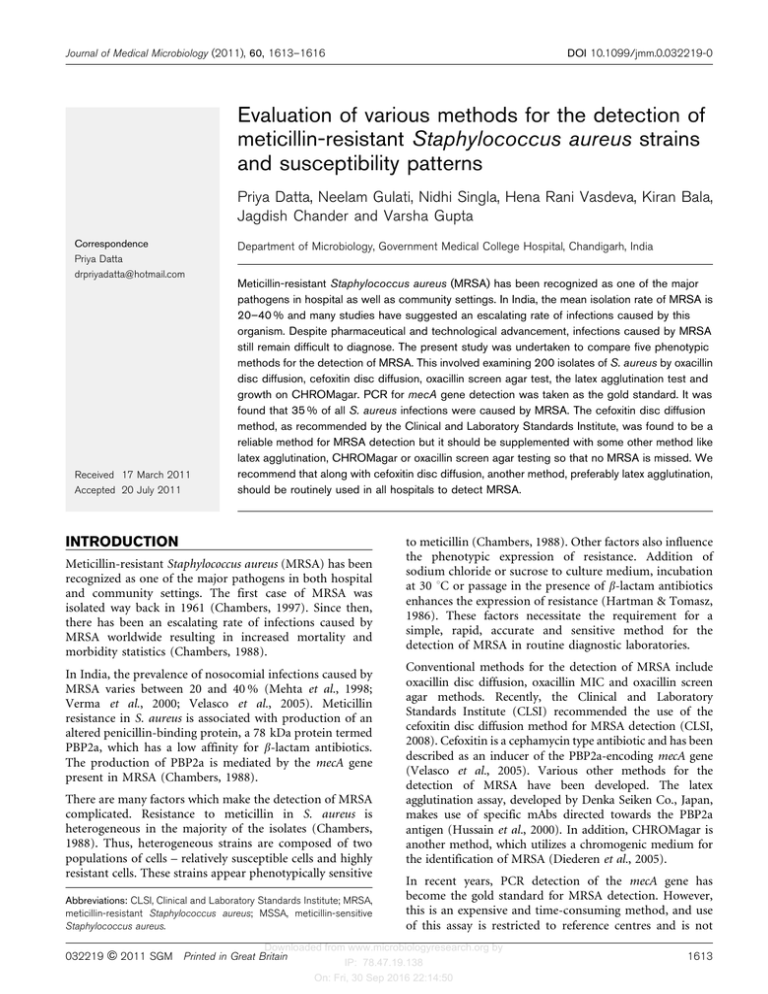
Journal of Medical Microbiology (2011), 60, 1613–1616 DOI 10.1099/jmm.0.032219-0 Evaluation of various methods for the detection of meticillin-resistant Staphylococcus aureus strains and susceptibility patterns Priya Datta, Neelam Gulati, Nidhi Singla, Hena Rani Vasdeva, Kiran Bala, Jagdish Chander and Varsha Gupta Correspondence Department of Microbiology, Government Medical College Hospital, Chandigarh, India Priya Datta drpriyadatta@hotmail.com Received 17 March 2011 Accepted 20 July 2011 Meticillin-resistant Staphylococcus aureus (MRSA) has been recognized as one of the major pathogens in hospital as well as community settings. In India, the mean isolation rate of MRSA is 20–40 % and many studies have suggested an escalating rate of infections caused by this organism. Despite pharmaceutical and technological advancement, infections caused by MRSA still remain difficult to diagnose. The present study was undertaken to compare five phenotypic methods for the detection of MRSA. This involved examining 200 isolates of S. aureus by oxacillin disc diffusion, cefoxitin disc diffusion, oxacillin screen agar test, the latex agglutination test and growth on CHROMagar. PCR for mecA gene detection was taken as the gold standard. It was found that 35 % of all S. aureus infections were caused by MRSA. The cefoxitin disc diffusion method, as recommended by the Clinical and Laboratory Standards Institute, was found to be a reliable method for MRSA detection but it should be supplemented with some other method like latex agglutination, CHROMagar or oxacillin screen agar testing so that no MRSA is missed. We recommend that along with cefoxitin disc diffusion, another method, preferably latex agglutination, should be routinely used in all hospitals to detect MRSA. INTRODUCTION Meticillin-resistant Staphylococcus aureus (MRSA) has been recognized as one of the major pathogens in both hospital and community settings. The first case of MRSA was isolated way back in 1961 (Chambers, 1997). Since then, there has been an escalating rate of infections caused by MRSA worldwide resulting in increased mortality and morbidity statistics (Chambers, 1988). In India, the prevalence of nosocomial infections caused by MRSA varies between 20 and 40 % (Mehta et al., 1998; Verma et al., 2000; Velasco et al., 2005). Meticillin resistance in S. aureus is associated with production of an altered penicillin-binding protein, a 78 kDa protein termed PBP2a, which has a low affinity for b-lactam antibiotics. The production of PBP2a is mediated by the mecA gene present in MRSA (Chambers, 1988). There are many factors which make the detection of MRSA complicated. Resistance to meticillin in S. aureus is heterogeneous in the majority of the isolates (Chambers, 1988). Thus, heterogeneous strains are composed of two populations of cells – relatively susceptible cells and highly resistant cells. These strains appear phenotypically sensitive Abbreviations: CLSI, Clinical and Laboratory Standards Institute; MRSA, meticillin-resistant Staphylococcus aureus; MSSA, meticillin-sensitive Staphylococcus aureus. 032219 G 2011 SGM to meticillin (Chambers, 1988). Other factors also influence the phenotypic expression of resistance. Addition of sodium chloride or sucrose to culture medium, incubation at 30 uC or passage in the presence of b-lactam antibiotics enhances the expression of resistance (Hartman & Tomasz, 1986). These factors necessitate the requirement for a simple, rapid, accurate and sensitive method for the detection of MRSA in routine diagnostic laboratories. Conventional methods for the detection of MRSA include oxacillin disc diffusion, oxacillin MIC and oxacillin screen agar methods. Recently, the Clinical and Laboratory Standards Institute (CLSI) recommended the use of the cefoxitin disc diffusion method for MRSA detection (CLSI, 2008). Cefoxitin is a cephamycin type antibiotic and has been described as an inducer of the PBP2a-encoding mecA gene (Velasco et al., 2005). Various other methods for the detection of MRSA have been developed. The latex agglutination assay, developed by Denka Seiken Co., Japan, makes use of specific mAbs directed towards the PBP2a antigen (Hussain et al., 2000). In addition, CHROMagar is another method, which utilizes a chromogenic medium for the identification of MRSA (Diederen et al., 2005). In recent years, PCR detection of the mecA gene has become the gold standard for MRSA detection. However, this is an expensive and time-consuming method, and use of this assay is restricted to reference centres and is not Downloaded from www.microbiologyresearch.org by IP: 78.47.19.138 On: Fri, 30 Sep 2016 22:14:50 Printed in Great Britain 1613 P. Datta and others routinely carried out in all laboratories (Velasco et al., 2005). 35 uC. Zone size was interpreted according to CLSI (2008) criteria: susceptible, ¢22 mm; resistant, ¡21 mm. The present study was undertaken to compare five phenotypic methods for the detection of MRSA, namely, the oxacillin disc diffusion method, the cefoxitin disc diffusion method, oxacillin screen agar, CHROMagar and the latex agglutination assay. PCR detection of the mecA gene was taken as the gold standard. The sensitivity and specificity of each test were determined in an attempt to find out the most suitable method, or combination thereof, for detection of MRSA in a routine diagnostic laboratory. Also, drug sensitivity patterns of MRSA and meticillinsensitive S. aureus (MSSA) were evaluated to find the drug of choice for these pathogens. Oxacillin screen agar test. A bacterial inoculum of each strain was made and turbidity was adjusted to 0.5 McFarland. One drop of this suspension was inoculated on Mueller–Hinton agar containing 4 % NaCl and 6 mg oxacillin ml21 (Hi-Media). Plates were incubated at 35 uC for 24 h. Any strains showing growth on the plate containing oxacillin were considered to be resistant to meticillin (Swenson et al., 2001). CHROMagar. CHROMagar (Hi-Media) is a new chromogenic medium for the identification of MRSA. For each strain, a bacterial suspension adjusted to 0.5 McFarland was used. Subsequently, a swab was dipped in the suspension and streaked onto a CHROMagar plate. The growth of any green colony was considered to be positive, indicating MRSA (Diederen et al., 2005). Latex agglutination test for detection of PBP2a. A latex METHODS Strains. Between January 2008 and December 2008, a total of 200 strains of S. aureus, isolated consecutively from various clinical samples in the Department of Microbiology, Government Medical College Hospital, Chandigarh, India, was evaluated. The clinical samples from which the strains were isolated were wound swab, drain fluid, tracheal aspirate, peritoneal fluid, pleural fluid and high vaginal swab. S. aureus was identified by characteristic growth on blood agar, MacConkey agar, Gram staining and various biochemical tests, e.g. catalase test, free and bound coagulase test, and anaerobic mannitol fermentation (Baird, 2006). PCR. All S. aureus isolates were subjected to DNA extraction followed by amplification of the mecA gene by PCR with primers mec 1 (59AAAATCGATGGTAAAGGTTGGC-39) and mec 2 (59-AGTTCTGCAGTACCGCATTTGC-39) synthesized by GenxBio. The reaction mixture (25 ml) consisted of 100 pmol each primer, Taq polymerase (2.5 U), Mg2+ (2.5 mM), 2.5 ml PCR buffer and 3 ml template DNA. The PCR programme was as follows: 3 min at 94 uC; followed by 40 cycles of a 30 s denaturation step at 94 uC, a 30 s annealing step at 45 uC and a 30 s extension at 72 uC; and a final 10 min extension step at 72 uC. The amplified product was a 533 bp sequence, which was detected by 1 % agarose gel electrophoresis with (0.5 mg ml21) ethidium bromide staining and observation under UV light. All strains positive for the mecA gene were designated MRSA (Skulnick et al., 1992). For PCR, positive and negative control strains [ATCC 43300 (mecApositive) and ATCC 29213 (mecA-negative), respectively] were used. Phenotypic detection methods All isolates of S. aureus were tested by oxacillin disc diffusion, cefoxitin disc diffusion, oxacillin screen agar and latex agglutination tests, and growth on CHROMagar. A standard strain of MSSA (ATCC 29213) and a PCR-positive control strain [ATCC 43300 (mecApositive)] were used as controls for all methods. Oxacillin disc diffusion method. All strains were tested with 1 mg oxacillin discs (Hi-Media) on Mueller–Hinton agar plates. For each strain, a bacterial suspension adjusted to 0.5 McFarland was used. The zone of inhibition was determined after 24 h incubation at 35 uC. Zone size was interpreted according to CLSI (2008) criteria: susceptible, ¢13 mm; intermediate, 11–12 mm; and resistant ¡10 mm. Cefoxitin disc diffusion method. All strains were tested with 30 mg cefoxitin discs (Hi-Media) on Mueller–Hinton agar plates. For each strain, a bacterial suspension adjusted to 0.5 McFarland was used. The zone of inhibition was determined after 16–18 h incubation at 1614 agglutination MRSA screen test (Denka Seiken) was carried out for all strains according to the manufacturer’s instructions (Hussain et al., 2000; Van Leeuwen et al., 1999). Antimicrobial susceptibility testing. The Kirby Bauer disc diffusion method was used routinely to detect the sensitivity of all S. aureus isolates and interpretations were made according to CLSI (2008) guidelines. All discs were supplied by Hi-Media. For MRSA, cotrimoxazole (25 mg), erythromycin (15 mg), clindamycin (10 mg), ciprofloxacin (30 mg), netilmicin (30 mg), amikacin (10 mg), linezolid (30 mg), vancomycin (30 mg) and dalfopristin/quinpristin (15 mg) were tested. For MSSA, the same antibiotics as for MRSA were used, as well as ampicillin (10 mg), cephalexin (30 mg) and amoxicillin/ clavulanic acid (30 mg). RESULTS A total of 200 clinical isolates of S. aureus was tested for the mecA gene by PCR. Out of the 200 strains, 70 were mecApositive and were labelled as MRSA. Thus, the prevalence of MRSA in our institute was 35 %. The remaining 130 strains were mecA-negative and were thus labelled as MSSA. Generally, MRSA showed a high level of resistance to all antimicrobial agents compared to MSSA (Table 1). A comparative table showing sensitivities and specificities, along with negative and positive predictive values of all the methods is shown in Table 2. DISCUSSION In our hospital, 35 % of all S. aureus infections are caused by MRSA. Susceptibility test profiles revealed a higher level of resistance to commonly prescribed antimicrobial agents among MRSA. All isolates were sensitive to vancomycin, linezolid and dalfopristin/quinpristin. These results were comparable to studies carried out by others (Anupurba et al., 2003). Accurate and early diagnosis of meticillin resistance is vital in the management of patients with infections caused by S. aureus. Although many phenotypic methods have been Downloaded from www.microbiologyresearch.org by IP: 78.47.19.138 On: Fri, 30 Sep 2016 22:14:50 Journal of Medical Microbiology 60 Comparison of detection methods for MRSA disadvantage with the cefoxitin disc is that the inhibition zones are very large and interfere with the zones of adjacent discs (Skov et al., 2003). Table 1. Antibiotic susceptibility patterns of S. aureus strains used in this study Antibiotic Ampicillin Cephalexin Amoxicillin/clavulanic acid Cotrimoxazole Erythromycin Clindamycin Ciprofloxacin Netilmicin Amikacin Vancomycin Linezolid Dalfopristin/quinpristin MSSA (%) MRSA (%) 98.7 98.7 75 80.8 82.9 98.7 53.9 98.7 98.7 100 100 100 The oxacillin screen agar test showed 97.1 % sensitivity and 100 % specificity for MRSA detection in our study. Swenson et al. (2001) noted that sensitivity decreased when heterogeneous resistant strains were tested and specificity decreased with strains having borderline MIC. Among the recently developed methods, CHROMagar showed 97.1 % sensitivity and 99.2 % specificity. This sensitivity could be increased to 100 % by increasing the incubation period of CHROMagar from 24 to 48 h (Diederen et al., 2005). However, the delay in obtaining the information will reduce the efficacy of this method. 2 2 2 75.6 55.4 72.4 29.8 93.7 63.8 100 100 98 This study found that, for the detection of MRSA, the latex agglutination test had 100 % sensitivity and 99.2 % specificity. Many recent studies have reported the sensitivity of the latex agglutination test to be ¢97 % (Cavassini et al., 1999; Louie et al., 2000; Udo et al., 2000). Latex agglutination has the advantages of being rapid, giving results on the same day, and easy to perform with very good sensitivity. This method could detect even low levels of PBP2a that are usually missed in routine disc diffusion methods. The only disadvantage is the cost factor. A study by Rohrer et al. (2001) proved that the sensitivity of the latex agglutination test can be improved (93.5 to 100 %) by induction with cefoxitin using growth from the edge of the inhibition zone of cefoxitin to perform the test. 2, Antibiotic not tested. developed to achieve this objective, the lacunae in the sensitivity of these tests in isolation may not ensure appropriate and timely treatment of all MRSA-infected patients. The current gold standard for MRSA detection is identification of the mecA gene. However, use of molecular methods for routine clinical practice may not be feasible in a budget-constrained setting. Therefore, it is desirable to identify an accurate, rapid and cost-effective phenotypic method for the detection of MRSA (Krishnan et al., 2002). In our study, the mecA gene PCR assay was used to classify 70 isolates as MRSA and the remaining 130 isolates as MSSA. Regarding the disc diffusion methods for detection of MRSA, the cefoxitin disc had a sensitivity of 98.5 %, whereas the oxacillin disc had a sensitivity of 91.4 %. Specificity for the cefoxitin disc was 100 %, whereas that for the oxacillin disc was 99.2 %. Various workers have shown that the cefoxitin disc method has better sensitivity than the oxacillin disc method for MRSA detection (Velasco et al., 2005; Boutiba-Ben Boubaker et al., 2004; Skov et al., 2003). This higher sensitivity to cefoxitin can be explained by the increased expression of the mecA-encoded protein PBP2a, cefoxitin being an inducer of the mecA gene (Velasco et al., 2005). Our study strengthens the point that cefoxitin is superior to oxacillin as an indicator of MRSA for the detection of meticillin resistance. The only One of the strains that was negative for mecA by PCR tested positive in the latex agglutination test. The result was confirmed by repeating both the tests. Sakoulas et al. (2001) faced the same discrepancy with one of their strains. They suggested the use of multiple colonies for PCR instead of a single colony as reported by most authors. In this study, multiple colonies were used for PCR, but this strain was still mecA-negative. Gene instability and primer design could be proposed as one of the reasons for the discrepancy. The key message is that such discrepancies should alert the microbiologist to this possibility as well. Laboratory errors in the detection of MRSA cause grave clinical consequences. False positivity results in the needless use of reserve second-line drugs like vancomycin and linezolid. This leads to more drug resistance and increases Table 2. Comparison of various methods for MRSA detection The total number of MRSA isolates was 70. NPV, Negative predictive value; PPV, positive predictive value. Method Oxacillin disc diffusion Cefoxitin disc diffusion Oxacillin screen agar CHROMagar Latex agglutination http://jmm.sgmjournals.org No. of false negatives No. of false positives Sensitivity (%) 6 1 2 2 0 1 0 0 1 1 91.4 98.5 97.1 97.1 100 Downloaded from www.microbiologyresearch.org by IP: 78.47.19.138 On: Fri, 30 Sep 2016 22:14:50 Specificity (%) NPV PPV 99.2 100 100 99.2 99.2 95.5 99.2 98.4 98.4 100 98.4 100 100 98.5 98.5 1615 P. Datta and others in health-care costs. False-negative reports of MRSA lead to treatment failure, and increased nosocomial and community spread of this deadly microbe. We found that the cefoxitin disc, as recommended by the CLSI, is a good method for MRSA detection but it should be supplemented with some other method so that no MRSA is missed. It is always advisable to combine two methods, one with high sensitivity and the other with high specificity. According to our results, the best combination is the cefoxitin disc diffusion method and the latex agglutination test. Since the latex agglutination test is expensive, it cannot be applied to all tests. Therefore, isolates that give a zone diameter of less than 20 mm can be easily reported as MRSA and only those with zone diameters of 20–22 mm need to be confirmed by latex agglutination. In conclusion, clinical microbiology laboratories associated with health-care facilities should combine screening with the cefoxitin disc along with another method that is feasible for that institute to reliably detect MRSA and control its spread. Hartman, B. J. & Tomasz, A. (1986). Expression of methicillin resistance in heterogeneous strains of Staphylococcus aureus. Antimicrob Agents Chemother 29, 85–92. Hussain, Z., Stoakes, L., Garrow, S., Longo, S., Fitzgerald, V. & Lannigan, R. (2000). Rapid detection of mecA-positive and mecA- negative coagulase-negative staphylococci by an anti-penicillin binding protein 2a slide latex agglutination test. J Clin Microbiol 38, 2051–2054. Krishnan, P. U., Miles, K. & Shetty, N. (2002). Detection of methicillin and mupirocin resistance in Staphylococcus aureus isolates using conventional and molecular methods: a descriptive study from a burns unit with high prevalence of MRSA. J Clin Pathol 55, 745–748. Louie, L., Matsumura, S. O., Choi, E., Louie, M. & Simor, A. E. (2000). Evaluation of three rapid methods for detection of methicillin resistance in Staphylococcus aureus. J Clin Microbiol 38, 2170–2173. Mehta, A. P., Rodrigues, C., Sheth, K., Jani, S., Hakimiyan, A. & Fazalbhoy, N. (1998). Control of methicillin resistant Staphylococcus aureus in a tertiary care centre: a five year study. Indian J Med Microbiol 16, 31–34. Rohrer, S., Tschierske, M., Zbinden, R. & Berger-Bächi, B. (2001). Improved methods for detection of methicillin-resistant Staphylococcus aureus. Eur J Clin Microbiol Infect Dis 20, 267–270. Sakoulas, G., Gold, H. S., Venkataraman, L., DeGirolami, P. C., Eliopoulos, G. M. & Qian, Q. (2001). Methicillin-resistant REFERENCES Anupurba, S., Sen, M. R., Nath, G., Sharma, B. M., Gulati, A. K. & Mohapatra, T. M. (2003). Prevalence of methicillin resistant Staphylococcus aureus in a tertiary referral hospital in eastern Uttar Pradesh. Indian J Med Microbiol 21, 49–51. Baird, D. (2006). Staphylococcus: cluster forming Gram positive cocci. In Mackie and McCartney: Practical Medical Microbiology, 14th edn, pp. 245–258. Edited by J. G. Collee, A. G. Fraser, B. P. Marmion & A. Simmons. New York: Churchill Livingstone. Boutiba-Ben Boubaker, I., Ben Abbes, R., Ben Abdallah, H., Mamlouk, K., Mahjoubi, F., Kammoun, A., Hammami, A. & Ben Redjeb, S. (2004). Evaluation of a cefoxitin disk diffusion test for the routine detection of methicillin-resistant Staphylococcus aureus. Clin Microbiol Infect 10, 762–765. Cavassini, M., Wenger, A., Jaton, K., Blanc, D. S. & Bille, J. (1999). Evaluation of MRSA-Screen, a simple anti-PBP 2a slide latex agglutination kit, for rapid detection of methicillin resistance in Staphylococcus aureus. J Clin Microbiol 37, 1591–1594. Chambers, H. F. (1988). Methicillin-resistant staphylococci. Clin Microbiol Rev 1, 173–186. Staphylococcus aureus: comparison of susceptibility testing methods and analysis of mecA-positive susceptible strains. J Clin Microbiol 39, 3946–3951. Skov, R., Smyth, R., Clausen, M., Larsen, A. R., Frimodt-Møller, N., Olsson-Liljequist, B. & Kahlmeter, G. (2003). Evaluation of a cefoxitin 30 mg disc on Iso-Sensitest agar for detection of methicillin-resistant Staphylococcus aureus. J Antimicrob Chemother 52, 204–207. Skulnick, M., Simor, A. E., Gregson, D., Patel, M., Small, G. W., Kreiswirth, B., Hathoway, D. & Low, D. E. (1992). Evaluation of commercial and standard methodology for determination of oxacillin susceptibility in Staphylococcus aureus. J Clin Microbiol 30, 1985–1988. Swenson, J. M., Williams, P. P., Killgore, G., O’Hara, C. M. & Tenover, F. C. (2001). Performance of eight methods, including two new rapid methods, for detection of oxacillin resistance in a challenge set of Staphylococcus aureus organisms. J Clin Microbiol 39, 3785–3788. Udo, E. E., Mokadas, E. M., Al-Haddad, A., Mathew, B., Jacob, L. E. & Sanyal, S. C. (2000). Rapid detection of methicillin resistance in staphylococci using a slide latex agglutination kit. Int J Antimicrob Agents 15, 19–24. Chambers, H. F. (1997). Methicillin resistance in staphylococci: Van Leeuwen, W. B., Van Pelt, C., Luijendijk, A., Verbrugh, H. A. & Goessens, W. H. (1999). Rapid detection of methicillin resistance in molecular and biochemical basis and clinical implications. Clin Microbiol Rev 10, 781–791. Staphylococcus aureus isolates by the MRSA-screen latex agglutination test. J Clin Microbiol 37, 3029–3030. CLSI (2008). Performance Standards for Antimicrobial Susceptibility Velasco, D., del Mar Tomas, M., Cartelle, M., Beceiro, A., Perez, A., Molina, F., Moure, R., Villanueva, R. & Bou, G. (2005). Evaluation of Testing, 15th informational supplement, M100-S15. Wayne, PA: Clinical and Laboratory Standards Institute. different methods for detecting methicillin (oxacillin) resistance in Staphylococcus aureus. J Antimicrob Chemother 55, 379–382. Diederen, B., Van Duijn, I., Van Belkum, A., Willemse, P., Van Keulen, P. & Kluytmans, J. (2005). Performance of CHROMagar MRSA medium Verma, S., Joshi, S., Chitnis, V., Hemwani, N. & Chitnis, D. (2000). for detection of methicillin-resistant Staphylococcus aureus. J Clin Microbiol 43, 1925–1927. Growing problem of methicillin resistant staphylococci – Indian scenario. Indian J Med Sci 54, 535–540. 1616 Downloaded from www.microbiologyresearch.org by IP: 78.47.19.138 On: Fri, 30 Sep 2016 22:14:50 Journal of Medical Microbiology 60
